Art market, Lucerne, by 1925; Jakob Goldschmidt (1882–1955), Berlin, by 1933; forced sale, Hugo Helbing, Frankfurt, June 23, 1936, lot 68; Dr. Irmgard Freiin von Lemmers Danforth (1892–1984), Wetzlar, Germany; given to the city of Wetzlar, Germany, 1963; restituted to the heirs of Jakob Goldschmidt, 2020; sale, Sotheby’s, London, December 5, 2020, lot 29; Benappi Fine Art, London
The support is composed of three principal planks of poplar wood, oriented vertically and glued together. Three smaller pieces are joined to these at the bottom, filling out the silhouette of the antependium. The thickness of the main planks is approximately 3 centimeters. Beneath the area of the frame, the depth of the wood support is increased by the addition of further layers of wood, built up to accommodate the varying projections of the decoration applied to it. All the slats of wood are glued and nailed to the support, as is the cartapesta surface. The cartapesta is composed of strips of material soaked in glue. It is unclear whether the full relief is composed of sections cast separately and then joined together or whether it was pulled from a single complete mold, but the surface reveals evidence of extensive recutting as the cartapesta was drying. A subsequent coating of thin gesso and hot glue smoothed some of the irregularities of the underlying surface and provided a suitable base for painting and the application of metallic leaf.
A thick, blackened varnish covering the entire painted surface and a much-degraded strip of red velvet covering the thickness of the tabernacle along its outer perimeter were removed in conservation of the relief by Daniele Rossi in 2020–21. Lifting sections of cartapesta in some areas of the frame were consolidated, but the only significant losses were found along the upper edge of the frame to left of center. A gap between two of the planks of the wooden support at the lower left of the tabernacle (viewed from the back) was stabilized with the insertion of a screw to prevent further movement of the planks but without applying pressure to the distortions it had already provoked. Losses in the support were filled with balsa on the reverse. The picture surface was cleaned and found to be in an exceptional state of preservation: its original gilding and polychromy, including delicate oil glazes, are intact and beautifully preserved. The coat of arms at the lower center had been effaced at an early date and scraped down to a preparatory layer of bolus with fragments of silver-leaf decoration, but virtually no other areas of pigment or gilding required reconstruction.
In its size, complexity of conception and execution, and astonishingly complete state of preservation, this cartapesta relief is a unique surviving object from fifteenth-century Italy. The central image shows the Virgin seated in left profile on a cloud of blue cherubim, with the naked Christ Child balanced on her right knee. She wears a blue cloak lined with green over a red and gold dress; a white veil covers her blonde hair and falls forward over both her shoulders. The Child looks out of the composition toward the right and raises His right hand in the same direction in a gesture of blessing. Hovering in the naturalistic sky, which shades from deep blue at the arched top to nearly white at the bottom, are three more cherubs supporting a garland of dark green leaves and golden fruit that is tied to their wings with pink ribbons. The lower ends of the garland are held by two angels, one peeking out from behind the Virgin’s shoulder at the right, the other standing, visible full length, looking dramatically away from the Virgin and out of the composition at the left. The frame is designed in illusionistic foreshortening to give the appearance of much greater depth than the actual cast, its shelf and heavy arched pediment painted to simulate white marble veined with gray. The arch is enlivened with moldings—pearl, rope, bead-and-reel, leaf-and-dart, and ovolo-and-dart—which are parcel gilt and highlighted with blue; it springs from oversized projecting corbels supported on two pair of blue and gilt candelabra. The antependium includes two stylized dolphins, painted in faux marble and parcel gilt, supporting a coat of arms (effaced), of which only the silver ground remains.
The technique of casting reliefs of the Virgin and Child that could be replicated as multiples originated in Florence in the third decade of the fifteenth century and was introduced to Siena by Donatello, one of the inventors of the process, during his sojourn there between 1457 and 1461.1 Donatello’s most astute follower in Siena was Francesco di Giorgio, who initially adapted the process, through the use of piece molds, to create elaborate sculptural decoration on wedding cassoni, a commercial specialty of the workshop that he operated jointly with Neroccio de’ Landi between 1469 and 1475. This molded decoration took two essentially different forms: shield-bearing figures cast as mirror images of each other and applied at either end of a painted narrative scene on the front face of the chest,2 or complete narrative reliefs comprising groups of two or more figures that could be reused and rearranged in different combinations on different chests.3 This second category, which also employed molded shield-bearing figures similar or identical to those in the first category, may have evolved from an earlier type of purely decorative pastiglia cassone often associated with early quattrocento Siena.4 Francesco di Giorgio’s partner, Neroccio, adapted the casting process to create at least two compositions of the Virgin and Child as a reproducible stucco relief. One, at the Art Institute of Chicago (fig. 1), exists in a unique surviving cast; the other is known in five replicas, variously in stucco, cartapesta, or wood.5 These replicas vary in size as well as medium, adding different painted details to the surface and, in one case, including five additional cherub heads cast from a piece mold. A cartapesta mirror frame in the Victoria and Albert Museum, London (fig. 2), is also correctly attributed to Neroccio and was probably designed to be reproduced in more than one example.6
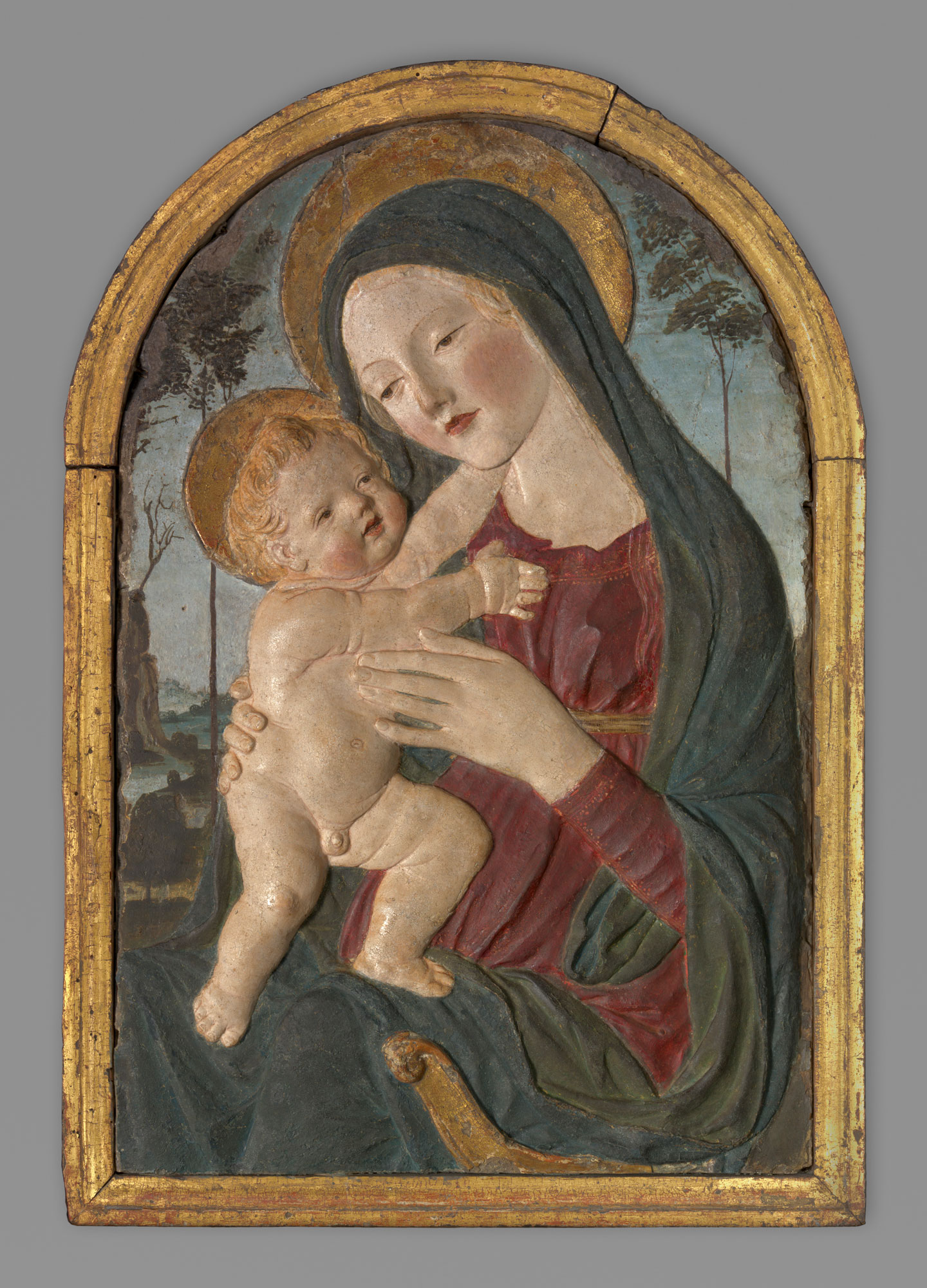
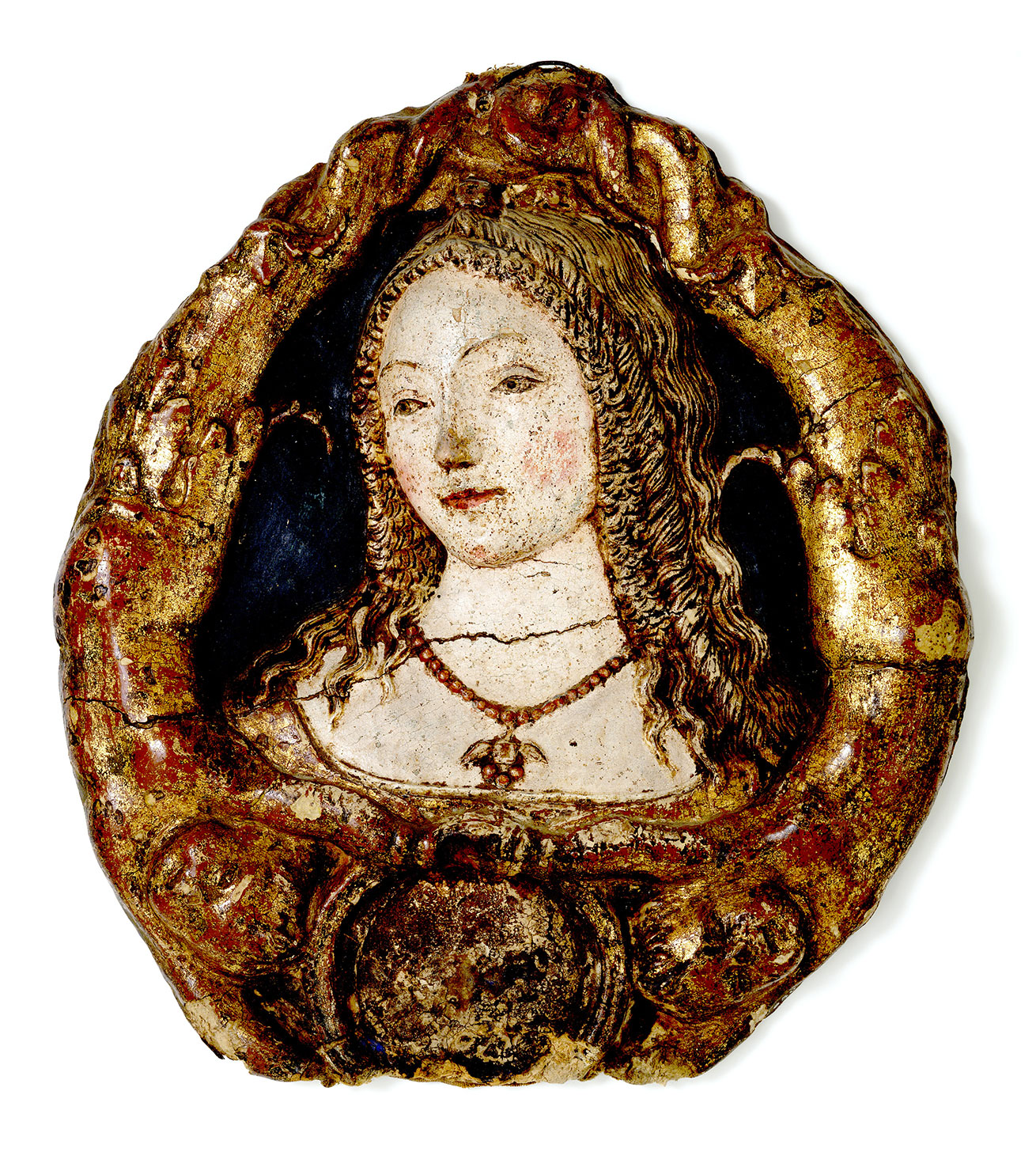
Although he enjoyed a prolific career as a sculptor, Francesco di Giorgio was, until recently, thought to have produced only two Virgin and Child reliefs that could be disseminated in molded replicas. One of these, in Berlin,7 reproduces a marble relief by Francesco, which is also now in Berlin (fig. 3), with recutting of the cast stucco for slightly greater relief effects that were then heightened by the surface polychromy.8 The other is a stucco relief of the Virgin and Child with cherubim, again in Berlin, that is, in turn, a partial copy of the cartapesta relief now at Yale.9 Four further attributions to Francesco di Giorgio of Virgin and Child reliefs advanced in recent studies include a bronze plaque in the Kunsthistorisches Museum, Vienna,10 a polychrome terracotta-and-stucco tabernacle in the church of San Sebastiano in Vallepiata, Siena,11 another stucco in Berlin,12 and a terracotta in the Hyde Collection, Glens Falls, N.Y.,13 but these reveal only a partial similarity of figure types to Francesco’s work and a very different approach to modeling draperies and anatomical volumes. While most if not all of these are to be recognized as Sienese, none of them has a strong claim to being the work of Francesco di Giorgio.
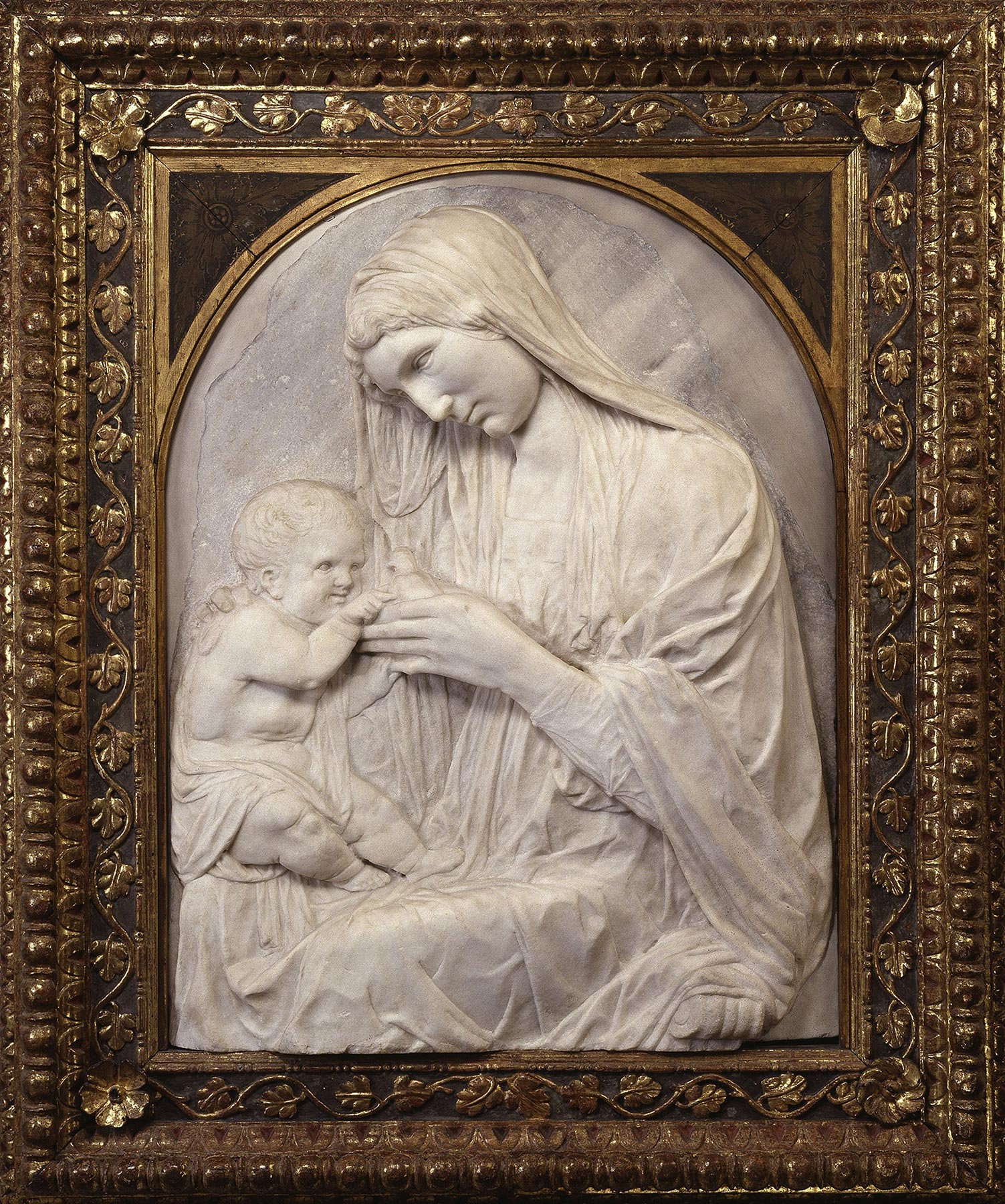
That the Yale relief was not conceived as a mechanical replica of a work in another medium—marble or bronze—is clear both from the subtlety of its surface effects, achieved by extensive recutting of the cartapesta after casting, and by the elaborate layered construction of the wood support, especially in the buildup of superimposed wedges to achieve the illusion of a projecting frame profile. The composition of the relief is directly inspired by Donatello, specifically by the marble relief known as the Madonna of the Clouds (fig. 4), now in the Museum of Fine Arts, Boston. This resemblance, and probably a tacit assumption that all of Francesco’s experiments with Virgin and Child compositions date from the first part of his career, before leaving Siena for Urbino around 1477, has led to a date close to 1475 for the Yale relief being repeated by the few authors who have referred to it. The figure style and impressionistic handling of surface detail revealed by cleaning, however, recall instead the masterful bronze reliefs Francesco di Giorgio created for the dukes Federigo and Guidobaldo da Montefeltro in Urbino in the late 1470s and the 1480s. Above all, its conception and handling resemble those of the large bronze plaquette of the Judgment of Paris in Washington, D.C. (fig. 5), assumed by consensus to be the latest of Francesco’s bronze reliefs.14 The standing angel at the left of the Yale relief, looking mysteriously and intensely out of the composition, is loosely based on the same model that Francesco devised, on a much larger scale, for the two bronze angels he cast for the high altar of Siena Cathedral around 1490. Finally, the workshop hand that aided him in pigmenting the frame and background of the relief—the painting of the Virgin and Child is clearly by Francesco himself—is unrelated to anything appearing among the workshop products for which Francesco and Neroccio can be easily recognized during the period of their partnership before 1475.
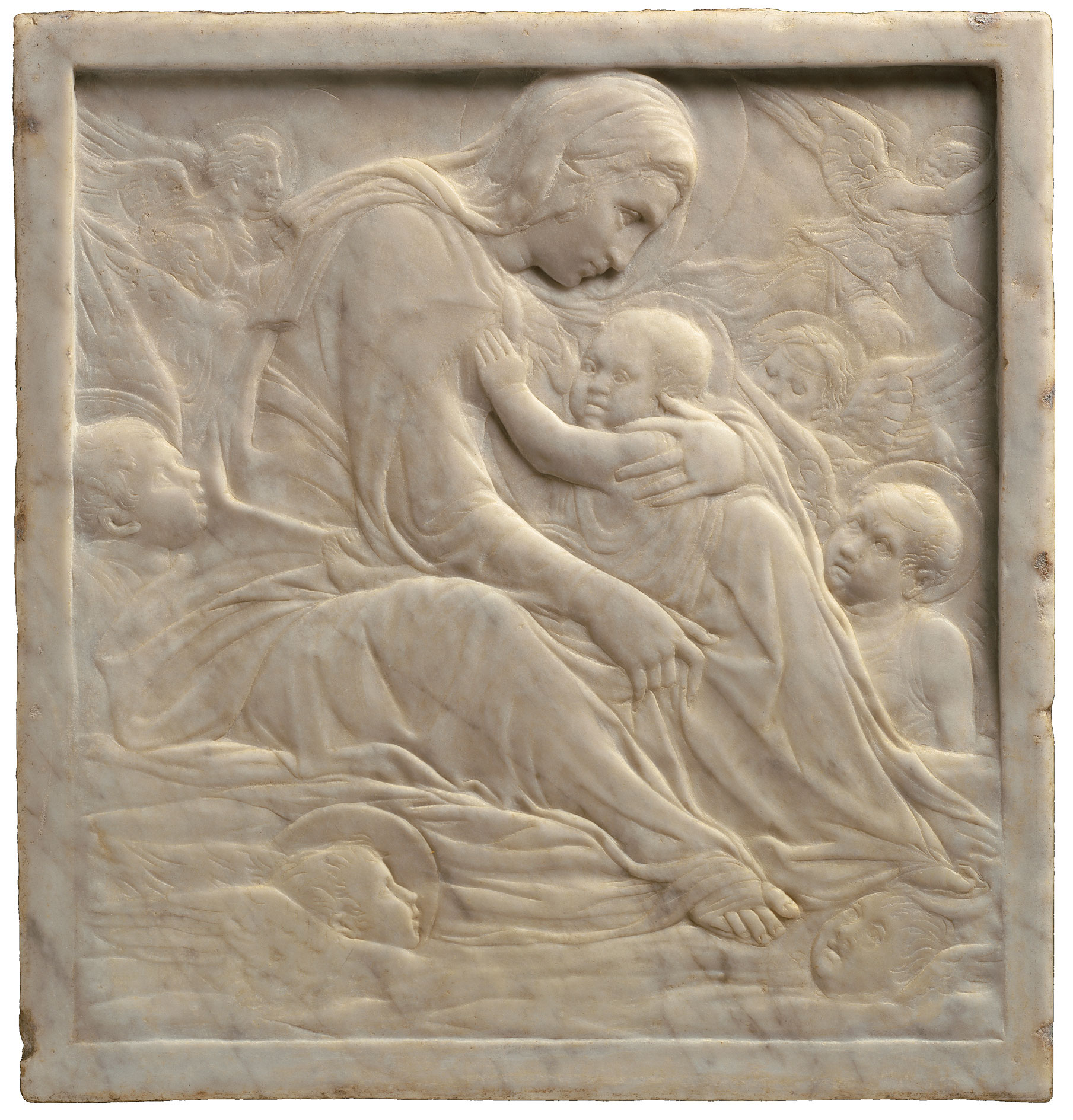

Francesco di Giorgio first experimented with trompe-l’oeil perspectival effects similar to those employed in the frame of this relief in designing the frame for his altarpiece of the Nativity painted between 1475 and 1480 for the monastery church of Monteoliveto a Porta Tufi in Siena (fig. 6), an unicum among Sienese altarpieces.15 There is thus a strong argument that the frame on the present relief would have been designed by him as well, but alternatively it may be attributable to a woodcarver/frame maker with whom he is documented working in 1488/89: Ventura di Ser Giuliano di Tura (documented 1488–1512). Two very similar frames survive, both of carved and gilded wood. One, in the Metropolitan Museum of Art, New York (fig. 7), contains a painting of the Virgin and Child by Benvenuto di Giovanni that appears to be original to it and may be datable to the 1480s.16 The other, in the Pieve di San Leonardo at Montefollonico, near Torrita di Siena, contains a polychrome terracotta sculpture by an unknown artist influenced by Francesco di Giorgio.17 The latter, like the frame on the present relief, employs illusionistic foreshortening to enhance the impression of its depth, an affectation that must be attributable directly to Francesco di Giorgio. There can be no doubt, however, that the Montefollonico frame and the frame on Benvenuto di Giovanni’s Virgin and Child were carved in the same workshop, and as there is no reason to assume that Francesco di Giorgio was actively employed designing and carving frames for other artists, Alessandro Bagnoli’s arguments for associating these works with Ventura di Ser Giuliano are highly plausible.18 —LK
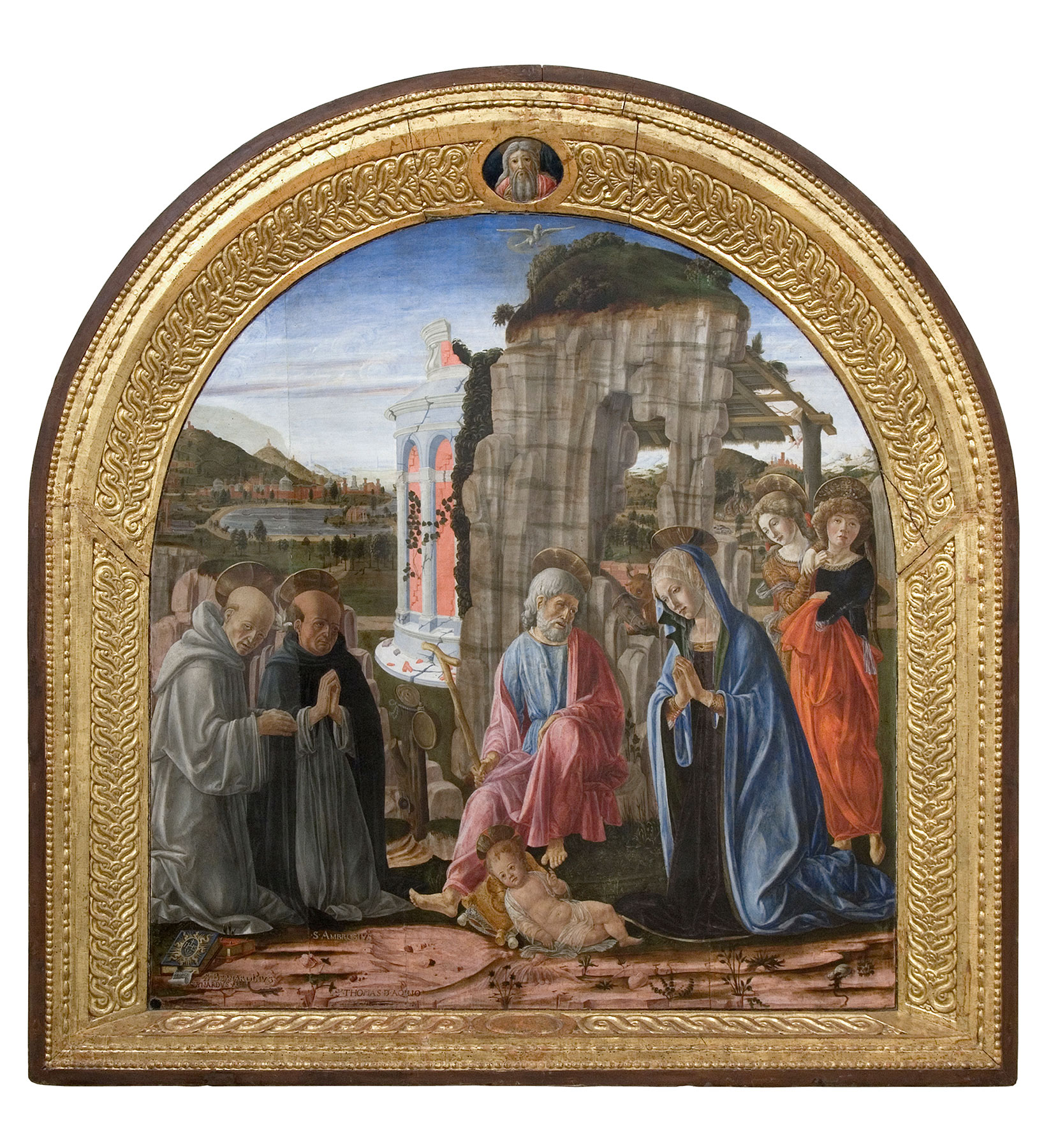
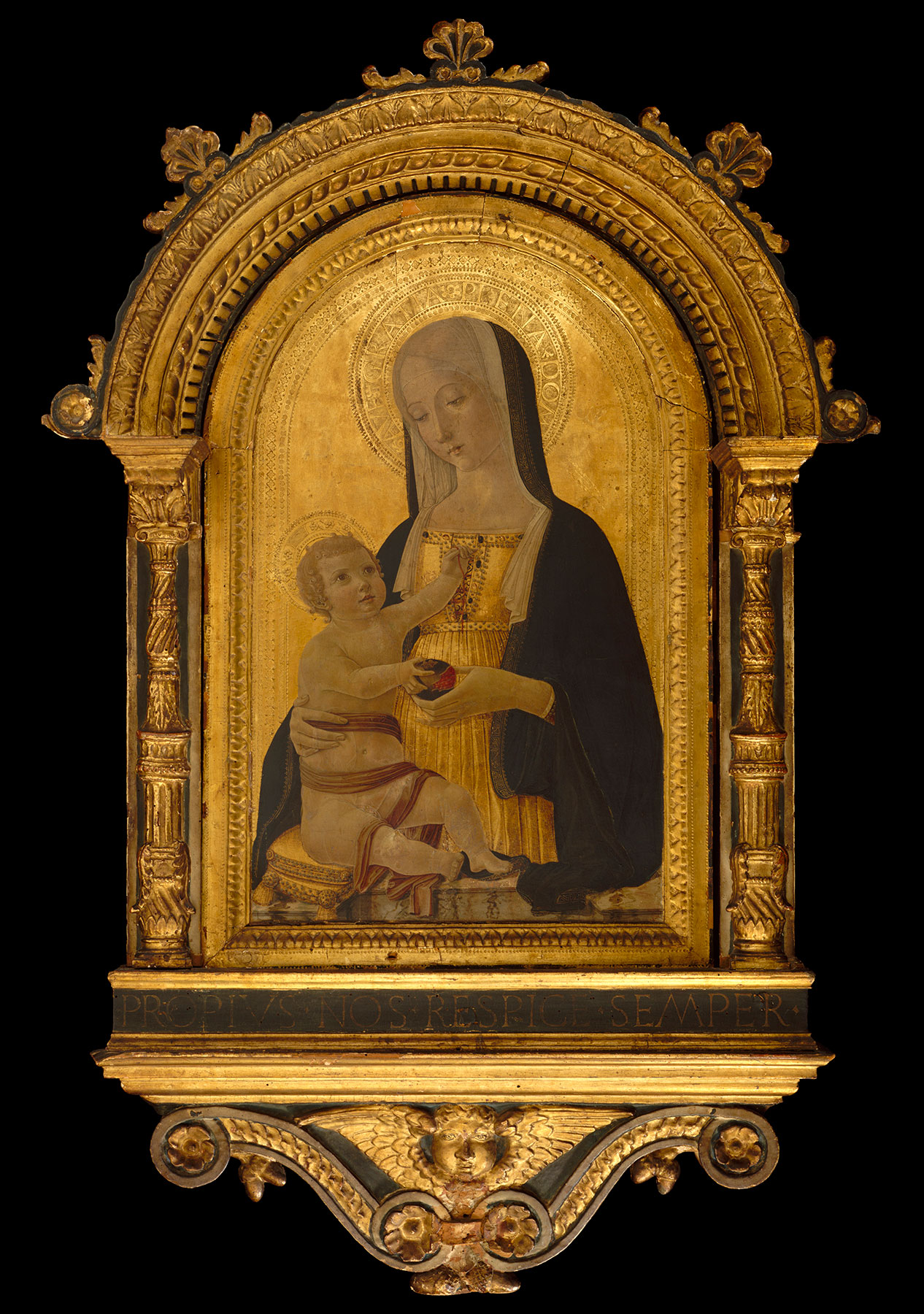
Published References
Bode, Wilhelm. Bertoldo und Lorenzo dei Medici: Die Kunstpolitik des Lorenzo il Magnifico im Spiegel der Werke seines Lieblingskunstlers Bertoldo di Giovanni. Freiburg-im-Bresgau, Germany: Pontos, 1925. , 63, 66; Schottmüller, Frida. Die italienischen und spanischen Bildwerke der Renaissance und des Barocks in Marmor, Ton, Holz, und Stuck. 2nd ed. Berlin: G. Reimer, 1933. , 65, no. 148; Laurence Kanter, in Newbery, Timothy J., George Bisacca, and Laurence B. Kanter, eds. Italian Renaissance Frames. Exh. cat. New York: Metropolitan Museum of Art, 1990. , 40–41; Koeppe, Wolfram. Die Lemmers-Danforth-Sammlung Wetzlar: Europäische Wohnkultur aus Renaissance und Barock. Heidelberg: Braus, 1992. , 308, 481, no. SK2; Alessandro Bagnoli, in Bellosi, Luciano, ed. Francesco di Giorgio e il Rinascimento a Siena, 1450–1500. Exh. cat. Milan: Electa, 1993. , 410–12; Newbery, Timothy J. The Robert Lehman Collection. Vol. 13, Frames. New York: Metropolitan Museum of Art, 2007. , 26; Amato, Gianluca. “Nuove considerazioni su alcune sculture di Francesco di Giorgio.” Prospettiva 172 (October 2018): 18–41., 22, 34n25; Alessandro Angelini, in Angelini, Alessandro, Gabriele Fattorini, and Giovanni Russo, eds. Federico da Montefeltro e Francesco di Giorgio: Urbino crocevia delle arti. Exh. cat. Venice: Marsilio, 2022. , 86n7
Notes
-
For an example by Donatello, see Yale University Art Gallery, inv. no. 2006.231.2, https://artgallery.yale.edu/collections/objects/116047. ↩︎
-
Examples include chests in the Museo Stibbert, Florence, inv. no. 4098; and the Victoria and Albert Museum, London, inv. no. W68-1925. ↩︎
-
Examples include chests in the Metropolitan Museum of Art, New York, inv. no. 15.119.4, https://www.metmuseum.org/art/collection/search/193194; the Isabella Stewart Gardner Museum, Boston, inv. no. F16e21; the Museo Artistico Industriale, Rome (Schubring, Paul. Cassoni: Truhen und Truhenbilder der italienischen Frührenaissance. Leipzig, Germany: K. W. Hiersemann, 1915., no. 51, pl. 9); the Museo Nazionale del Bargello, Florence (Schubring, Paul. Cassoni: Truhen und Truhenbilder der italienischen Frührenaissance; Ein Beitrag zur Profanmalerei im Quattrocento. 2nd rev. ed. Leipzig, Germany: Karl W. Hiersemann, 1923. , no. 895, pl. 1); formerly the Figdor collection, Vienna (Schubring, Paul. Cassoni: Truhen und Truhenbilder der italienischen Frührenaissance. Leipzig, Germany: K. W. Hiersemann, 1915., no. 63, pl. 10); Moravska Galerie, Brno, Czech Republic, inv. no. 7024; the Museo Bagatti Valsecchi, Milan, inv. no. 27; the Carmen Thyssen-Bornemisza Museo Nacional, Madrid, inv. no. DEC 0034; and the Victoria and Albert Museum, London, inv. 719-1884, https://collections.vam.ac.uk/item/O130446/cassone-front-unknown/. See Laurence Kanter, in Christiansen, Keith, Laurence Kanter, and Carl Brandon Strehlke. Painting in Renaissance Siena, 1420–1500. Exh. cat. New York: Metropolitan Museum of Art, 1988., 322n1; Freuler, Gaudenz. “Manifestatori delle cose miracolose”: Arte italiana del ’300 e ’400 da collezioni in Svizzera e nel Liechtenstein. Exh. cat. Lugano-Castagnola, Switzerland: Fondazione Thyssen-Bornemisza, 1991., 104–5; Chiara Guerzi, in De Marchi, Andrea, Chiara Guerzi, and Gianna Nunziati, eds. Due cassoni in oro e in argento: L’arte nuziale a Perugia e a Siena verso il 1440. Exh. cat. Florence: Botticelli via Maggio, 2009. , 26–39; and esp. Calderai, Fausto, and Alan Chong. Furnishing a Museum: Isabella Stewart Gardner’s Collection of Italian Furniture. Boston: Isabella Stewart Gardner Museum, 2011. , 112–17. Guerzi (following Andrea De Marchi, in De Marchi, Andrea, Chiara Guerzi, and Gianna Nunziati, eds. Due cassoni in oro e in argento: L’arte nuziale a Perugia e a Siena verso il 1440. Exh. cat. Florence: Botticelli via Maggio, 2009. , 7–8) believed this group of Sienese chests can be dated to the second quarter of the fifteenth century and therefore reflect an earlier stylistic and technical tradition than Francesco di Giorgio’s. ↩︎
-
Examples include Metropolitan Museum of Art, New York, Robert Lehman Collection, inv. no. 1975.1.1938, https://www.metmuseum.org/art/collection/search/459250; Museo Stefano Bardini, Florence; Castel Sant’Angelo, Rome; Grassi Museum für Angewandte Kunst, Leipzig, Germany (see Schottmüller, Frida. Furniture and Interior Decoration of the Italian Renaissance. Stuttgart, Germany: Julius Hoffmann, 1928. , 241, fig. 82); Museum für Angewandte Kunst, Cologne, Germany; Victoria and Albert Museum, London, inv. no. 717-1884, https://collections.vam.ac.uk/item/O321640/cassone-panel-unknown/; Isabella Stewart Gardner Museum, Boston, inv. no. F16w8, https://www.gardnermuseum.org/experience/collection/11742; Virginia Museum of Fine Arts, Richmond, inv. no. 68.17, https://vmfa.museum/piction/6027262-15905120/; National Gallery of Canada, Ottawa, inv. no. 23644; and elsewhere. See Koeppe, Wolfram, et al. The Robert Lehman Collection. Vol. 15, Decorative Arts. New York: Metropolitan Museum of Art, 2012. , 195–96. ↩︎
-
Stucco versions are found in the Museo d’Arte della Maremma, Grosseto, and the Museo Bardini, Florence. Cartapesta squeezes are owned by the Princeton University Art Museum, N.J., inv. no. y1962-74, and formerly by the Kaiser Friedrich Museum, Berlin (destroyed in 1945). A carved wood version is in the Perkins Collection at the Sacro Convento di San Francesco, Assisi. ↩︎
-
See Luke Syson, in Syson, Luke, ed. Renaissance Siena: Art for a City. Exh. cat. London: National Gallery, 2007. , 208–12. A related mirror frame, carved in wood and bearing the arms of the Cinuzzi of Siena, possibly associated with the workshop of the sculptor Giovanni di Stefano, is in the Metropolitan Museum of Art, New York, Robert Lehman Collection, inv. no. 1975.1.2101, https://www.metmuseum.org/art/collection/search/459206; see Newbery, Timothy J. The Robert Lehman Collection. Vol. 13, Frames. New York: Metropolitan Museum of Art, 2007. , 28–29. ↩︎
-
Skulpturensammlung und Museum für Byzantinische Kunst, Staatliche Museen zu Berlin, inv. no. 7121. ↩︎
-
Two other stucco replicas of this composition—in the Salini Collection, Castello di Gallico, Asciano, and in the Victoria and Albert Museum, London (inv. no. A37-1953, https://collections.vam.ac.uk/item/O314479/virgin-and-child-relief-martini-francesco-di/; see also Alessandro Bagnoli, in Bellosi, Luciano, ed. Francesco di Giorgio e il Rinascimento a Siena, 1450–1500. Exh. cat. Milan: Electa, 1993. , 196–97)—are later squeezes possibly taken not from the original mold but from another stucco example. Their surface detail is blunt and simplified and without evident recutting in any details. ↩︎
-
Skulpturensammlung und Museum für Byzantinische Kunst, Staatliche Museen zu Berlin, inv. no. 1561. Kanter, in Christiansen, Keith, Laurence Kanter, and Carl Brandon Strehlke. Painting in Renaissance Siena, 1420–1500. Exh. cat. New York: Metropolitan Museum of Art, 1988., 332; and Laurence Kanter, in Newbery, Timothy J., George Bisacca, and Laurence B. Kanter, eds. Italian Renaissance Frames. Exh. cat. New York: Metropolitan Museum of Art, 1990. , 40–41. The Berlin stucco was again probably squeezed not from the original mold(s) that produced the Yale relief but from a cast of an existing stucco or cartapesta squeeze. Not only does it reduce surface detail to a minimum, but also it converts the composition to a vertical rectangular format and crops the two angels on either side of the Virgin. ↩︎
-
Inv. no. KK9118, https://www.khm.at/objektdb/detail/95135/; see Gianluca Amato, in Angelini, Alessandro, Gabriele Fattorini, and Giovanni Russo, eds. Federico da Montefeltro e Francesco di Giorgio: Urbino crocevia delle arti. Exh. cat. Venice: Marsilio, 2022. , 92–93. ↩︎
-
See Bagnoli, in Bellosi, Luciano, ed. Francesco di Giorgio e il Rinascimento a Siena, 1450–1500. Exh. cat. Milan: Electa, 1993. , 222–25. ↩︎
-
Skulpturensammlung und Museum für Byzantinische Kunst, Staatliche Museen zu Berlin, inv. no. 2942; see Bagnoli, in Bellosi, Luciano, ed. Francesco di Giorgio e il Rinascimento a Siena, 1450–1500. Exh. cat. Milan: Electa, 1993. , 222–25. ↩︎
-
Inv. no. 1971.88, https://emuseum.hydecollection.org/objects/1204/madonna-and-child. Another version of this relief is in storage at the Pinacoteca Nazionale, Siena; see Amato, Gianluca. “Nuove considerazioni su alcune sculture di Francesco di Giorgio.” Prospettiva 172 (October 2018): 18–41., 22. ↩︎
-
See Francesca Fumi Cambi Gado, in Bellosi, Luciano, ed. Francesco di Giorgio e il Rinascimento a Siena, 1450–1500. Exh. cat. Milan: Electa, 1993. , 406–7. ↩︎
-
The altarpiece was commissioned on April 12, 1475, and is usually discussed as having been painted shortly afterward. See Alessandro Angelini, in Bellosi, Luciano, ed. Francesco di Giorgio e il Rinascimento a Siena, 1450–1500. Exh. cat. Milan: Electa, 1993. , 314–17. Fabio Chigi, however, in 1625–26, recorded the inscription “Franciscus Georgii 1480” on the painting, and Gabriele Fattorini has recently suggested that such a date, implying a prolonged execution, could explain the predominant use of an oil technique following Francesco di Giorgio’s exposure to the paintings of Justus of Ghent and Pedro Berrugquete in Urbino. See Gabriele Fattorini, in Angelini, Alessandro, Gabriele Fattorini, and Giovanni Russo, eds. Federico da Montefeltro e Francesco di Giorgio: Urbino crocevia delle arti. Exh. cat. Venice: Marsilio, 2022. , 53–54. ↩︎
-
See Newbery, Timothy J. The Robert Lehman Collection. Vol. 13, Frames. New York: Metropolitan Museum of Art, 2007. , 26–27. Benvenuto di Giovanni’s Virgin and Child is usually dated to the early part of his career, based chiefly on the putative existence of the arms of Pope Pius II Piccolomini (died 1465) on its reverse, now lost. The painting is more likely to have been made in the 1480s, close to the surviving lunette from the Bellanti altarpiece of 1483. See Benvenuto di Giovanni, Virgin and Child with Two Saints and Two Angels. ↩︎
-
See Bagnoli, in Bellosi, Luciano, ed. Francesco di Giorgio e il Rinascimento a Siena, 1450–1500. Exh. cat. Milan: Electa, 1993. , 410–13. Bagnoli’s dating of this relief around 1475 is based on the assumption that the two related frames were made close to that date, a circular argument. The painted background of the Montefollonico relief—which is closer in style to the landscapes of Neroccio de’ Landi than to the Master of Griselda, as suggested by Bagnoli—points to a more probable date around or shortly after 1490. ↩︎
-
For Ventura di Ser Giuliano, see also Martini, Laura. “L’oratorio di San Bernardino.” In Domenico Beccafumi e il suo tempo, 600–21. Exh. cat. Milan: Electa, 1990. , 602–4, 621n11. The classicizing frames surviving on altarpieces by Pietro di Francesco Orioli (died 1496) all repeat the profiles, with minor variations in ornament, of the three tabernacles discussed above and might have been produced in Ventura di Ser Giuliano’s workshop as well. ↩︎